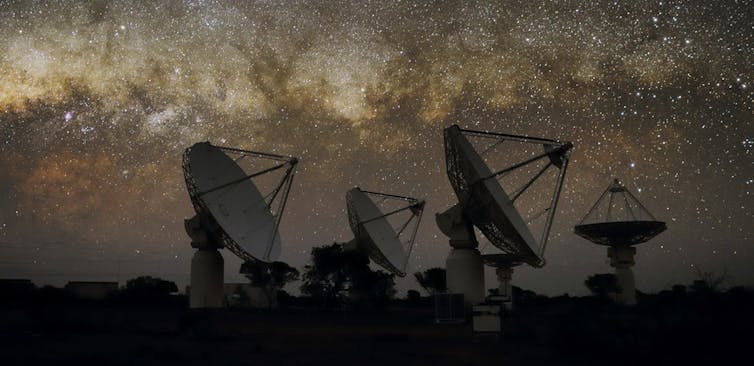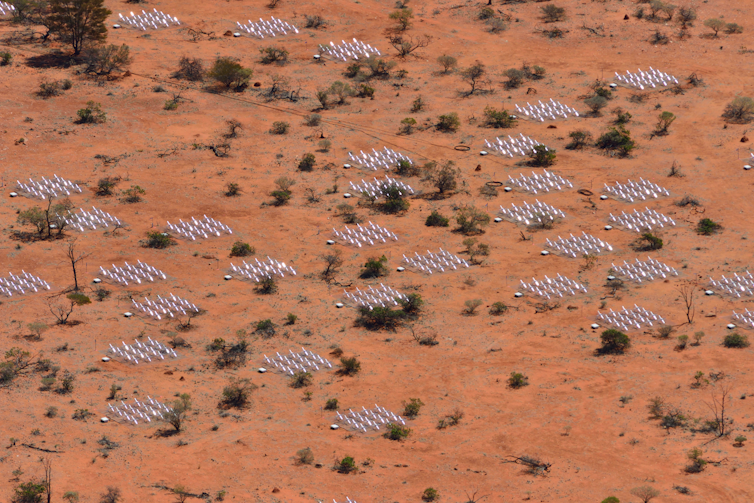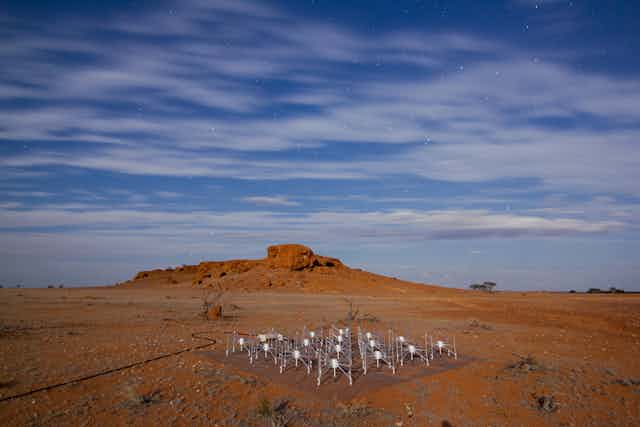The Square Kilometre Array (SKA) radio telescope has been on the cards since the early 1990s. It took until May of last year to find out where it will be built – in South Africa, Australia and New Zealand – and it will be another seven years until the first science starts coming out of the facility.
So what are the challenges facing the development and construction of the SKA? And what can we learn from existing projects to ensure a smooth development and roll-out for the SKA?
A complex instrument
Once constructed, the SKA will be a radio telescope with a collecting surface area (equivalent to the lens or mirror in an optical telescope) of one square kilometre.
This collecting area will be made up of thousands to millions of small radio telescopes, scattered over at least hundreds of kilometres (using a technique called interferometry). These telescopes will be connected together with super-high-speed optical fibre and data will be fed into what will be the biggest supercomputer in the world.
The SKA will be sensitive enough to study normal galaxies billions of light years away, thereby allowing the study of the structure and evolution of the universe. We hope this will start to reveal the nature of “dark energy” and “dark matter” – mysterious but apparently fundamental constituents of the universe.
But before the science gets underway, there are a number of clear challenges that need to be overcome:
- the SKA is a complex consortium of nine financial member countries which bring varying degrees of funding, expertise and capacity to the table
- the project will be executed on three sites in three separate countries (with a head office in a fourth country)
- the science goals are many and varied
- four different base telescope technologies are included in the high-level design
- technical and engineering boundaries will be simultaneously pushed in multiple directions
- the final design and construction phases will span more than ten years, and
- the project is not yet fully funded.
These challenges are why we pursue projects such as the SKA. The SKA is an example of global mega-science, internationally focused on the biggest questions facing physics, fostering maximum technical innovation and encouraging future generations of scientists, engineers and computer programmers to take on large and complex problems.
The international community is smart enough not to launch into a project such as the SKA without taking some “baby” steps. Thus, a number of serious SKA pathfinder telescopes are being built.

Finding our way
Two pathinders are being built in Western Australia – the Australian Square Kilometre Array Pathfinder, and the Murchison Widefield Array (MWA) – one is being built in South Africa – MeerKAT – and one is being built in The Netherlands, called LOFAR.
These prototypes are being used to ensure the technology used in the SKA will work, and also to help further refine and develop such technology. In fact, between them, the four pathfinders cover three of the four SKA telescope technologies.
Now that the site decision has been made, the SKA project enters a four-year final design stage. During this period, the pathfinder telescopes will come online.
The intention is that the experience in constructing and operating the pathfinders will inform the final SKA design. There are a vast number of things to learn from the pathfinders (especially those in Western Australia and South Africa) on the engineering, science and computing fronts.
The MWA and LOFAR aim to get the first hints regarding the formation of the first stars and galaxies in the universe, more than 13 billion years ago. These first results will guide the final specifications for the SKA in taking the next big step: imaging structure formation in the early universe in great detail.
On the right track
I’m the Project Director for one of the pathfinder telescopes, the MWA, which has reached the point of construction completion and was formally launched at the end of November 2012.
The MWA will be the first pathfinder operational for science on either of the two SKA sites, from early 2013.

The parallels between the MWA and the SKA are more than passing.
The MWA has been built by a complex consortium of 13 institutions from four countries. We have learnt a lot about the costs and benefits of a highly distributed workforce and we believe these lessons are applicable to the SKA.
The MWA project is a low-frequency telescope, same as the main component of the SKA that will come to Western Australia. Indeed the MWA has been built on the SKA site. We have learnt a lot about building low-frequency telescopes in the exact physical conditions the SKA will experience.
The MWA has science goals ranging from observations of the sun to observations of the early universe when the first stars and galaxies formed. Like the SKA, we have had to balance the demands of a wide range of science goals.
Only in the last 12 months of the MWA construction project did we understand our final budgetary envelope. This means we’ve had great experience designing to cost, strategically scoping the project, managing risks, engaging industry partners, managing stakeholder expectations and scheduling work.
The SKA is in the same boat with respect to its funding and the project will need to get started on design and prototyping before understanding how much money is available for construction.

Separate, but together
One of the big lessons we’ve learnt with the MWA is to seek, where possible, to decouple different elements of the project from each other to reduce dependencies and allow different parts of the work to proceed in parallel. In doing this, we had to retain flexibility of design, to react to changing financial conditions.
For the low-frequency component of the SKA, a big lesson learnt from the MWA was that the supporting infrastructure (a big cost and risk driver because it has a long lead time, requires a large number of contractors and sub-contractors, and is subject to wider market forces such as the construction industry) could be largely decoupled from the problem of the exact placement of antennas.
Inherent in the design of low-frequency antenna arrays is the flexibility to undertake some of the heavy work of infrastructure deployment (joining of power and optical fibre, on-site buildings and high-speed data transport) in parallel with finalisation of the design and placement of the antennas.
While I think we have learnt many lessons from the MWA, this is the biggest lesson that helped us toward delivery. If applied to the SKA, decoupling infrastructure and instrument will make the most of the natural advantages of the low-frequency technologies, reduce risk and may collapse the overall schedule (and cost).
It’s been more than two decades since the SKA concept first emerged and it will be another decade until the facility is operating at its planned full capacity.
There is, of course, much work to be done between now and then, but if we take into account similar existing and ongoing projects, we’ll give ourselves the best chance of a smooth SKA roll-out.
I acknowledge the Wadjarri Yamatji people as the traditional owners of the land on which the MWA has been built.

